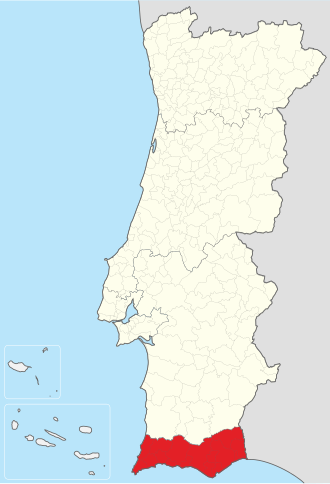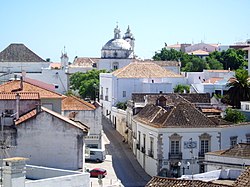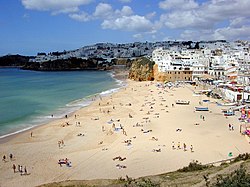Algarve
The Algarve (from Arabic: الغرب al-Gharb "the West") is the southernmost region of continental Portugal. The capital of the Algarve is the city of Faro. There is an international airport and a public university (University of Algarve).
| colspan="2" style="text-align: center; font-weight: bold; font-size: 1.25em; background-color: Template:Geobox2 color;" | Algarve | |
| colspan="2" style="text-align: center; background-color: Template:Geobox2 color;" | Region | |
The city of Silves, the old capital of the Algarve .
| |
| Name origin: algarve from Arabic: الغرب the west | |
| Country | Portugal |
|---|---|
| Capital | Faro |
| - elevation | 11 m (36 ft) |
| - coordinates | 37°0′52″N 7°56′7″W / 37.01444°N 7.93528°W |
| Highest point | Fóia |
| - location | Serra de Monchique |
| - elevation | 902 m (2,959 ft) |
| - coordinates | 37°18′54″N 8°35′47″W / 37.31500°N 8.59639°W |
| Lowest point | Sea level |
| - location | Atlantic Ocean |
| - elevation | 0 m (0 ft) |
| Length | 143 km (89 mi), East-West |
| Width | 63 km (39 mi), North-South |
| Area | 4,996.80 km² (1,929 sq mi) [1] |
| Density | 89 /km² (231 /sq mi) |
| GDP (nominal) | 2013 estimate |
| - Total | € 7.232 billion[2] |
| - Per capita | € 16,300[2] |
| Statistics from INE (2011) | |
The present region of Algarve coincides with the old province of the same name and with the Faro district. The main economic activity in the region is tourism because its beaches and its historical buildings.
History
The name Algarve comes from Gharb Al-Andalus (Arabic: غرب الأندلس, gharb al-ʼandalus; "The West of Al-Andalus"), or just Al-Gharb (Arabic: الغرب, al-gharb; "The West"), the name given by the Muslims of Iberia to the region to the west of Andalusia.[3]
Geography
Algarve has an area of 744.57 km2 (287.48 sq mi).[1] It borders with the Alentejo region (Alentejo Litoral and Baixo Alentejo subregions) to the north, the Atlantic Ocean to the west and south, and the Guadiana river, and Andalusia (Spain), to the east.
The Algarve region is divided in two zones, each with eight municipalities:
- Barlavento, the western zone, with Portimão as main city; and
- Sotavento, the eastern zone, with Faro as main city.
The main mountain ranges are Serra de Monchique, la Serra de Espinhaço de Cão and Serra do Caldeirão. The highest point in the region is the Fóia mountain, 902 m (2,959 ft) high,[4] in the Serra de Monchique mountain range.
The westernmost point of the region, and of continental Europa, is Cape St. Vincent (Portuguese: [Cabo de São Vicente] Error: {{Lang}}: text has italic markup (help)),[5] in the municipality of Vila do Bispo.
Administrative division
Algarve is formed by 16 municipalities (or concelhos) and 67 freguesias.
| Map | Municipality | Population (2011) |
Area (km²) |
Population density |
Freguesias |
|---|---|---|---|---|---|
| Barlavento zone | |||||
| 1 | Vila do Bispo | 5,258 | 179.06 | 29.4 | 4 |
| 2 | Aljezur | 5,884 | 323.50 | 18.2 | 4 |
| 3 | Monchique | 6,045 | 395.30 | 15.3 | 3 |
| 4 | Lagos | 31,049 | 212.99 | 145.8 | 4 |
| 5 | Portimão | 55,614 | 182.06 | 305.5 | 3 |
| 6 | Lagoa | 22,975 | 88.25 | 260.3 | 4 |
| 7 | Silves | 37,126 | 680.06 | 54.6 | 6 |
| 8 | Albufeira | 40,828 | 140.66 | 290.3 | 4 |
| Sotavento zone | |||||
| 9 | Loulé | 70,622 | 763.67 | 92.5 | 9 |
| 10 | Faro | 64,560 | 202.57 | 318.7 | 4 |
| 11 | São Brás de Alportel | 10,622 | 153.37 | 69.3 | 1 |
| 12 | Olhão | 45,396 | 130.86 | 346.9 | 4 |
| 13 | Tavira | 26,167 | 606.97 | 43.1 | 6 |
| 14 | Alcoutim | 2,917 | 575.36 | 5.1 | 4 |
| 15 | Castro Marim | 6,747 | 300.84 | 22.4 | 4 |
| 16 | Vila Real de Santo António | 19,156 | 61.25 | 312.8 | 3 |
Among the 16 municipalities, Loulé is the largest of the region, with an área of 763.67 km2 (294.85 sq mi); this municipality and Silves border both the Alentejo region and the Atlantic Ocean. Vila Real de Santo António is the smallest municipality with an área of 61.25 km2 (23.65 sq mi).
Only three municipalities do not border the ocean: Monchique, São Brás de Alportel and Alcoutim.
Economy

Farming products of the region include fig, almond, orange, carob bean, strawberry tree and cork oak. Horticulture is also important. Fishing and aquaculture are important activities in the coastal area of Algarve.
The wines of the region are well-known. There are four wines in the region which have Protected Designation of Origin (Denominação de Origem Controlada – DOC): Lagoa DOC, Lagos DOC, Portimão DOC and Tavira DOC.
Food processing, cement and construction, are the main industries.
Tourism related activities are extensive and make the bulk of Algarve's economy during summer time.
Gallery
References
- ↑ 1.0 1.1 "Portal de Estatísticas Oficiais". Instituto Nacional de Estatística - Statistics Portugal. 16 June 2014. Retrieved 6 August 2016.
- ↑ 2.0 2.1 2.2 2.3 "EU Regions". Eurostat.
- ↑ A. Huici Miranda. "G̲h̲arb al-Andalus" (in français). Encyclopédie de l’Islam. Retrieved 7 August 2016.
- ↑ "Mont Fóia" (in français). Guide michelin. Retrieved 7 August 2016.
- ↑ "Cabo de São Vicente" (in français). Internaute.com. Retrieved 7 August 2016.
Other websites
| Wikimedia Commons has media related to Lua error in Module:Commons_link at line 62: attempt to index field 'wikibase' (a nil value).. |
 Algarve travel guide from Wikivoyage
Algarve travel guide from Wikivoyage- Associação de Turismo do Algarve










